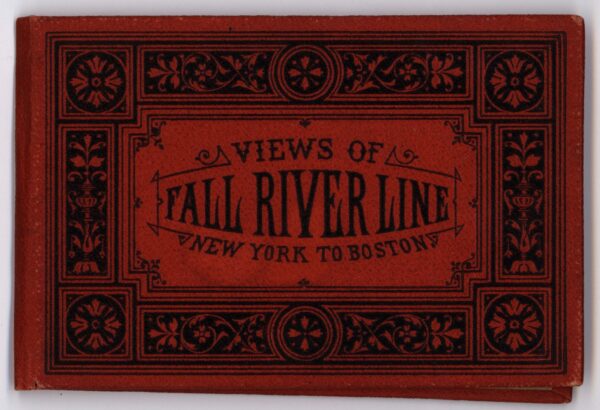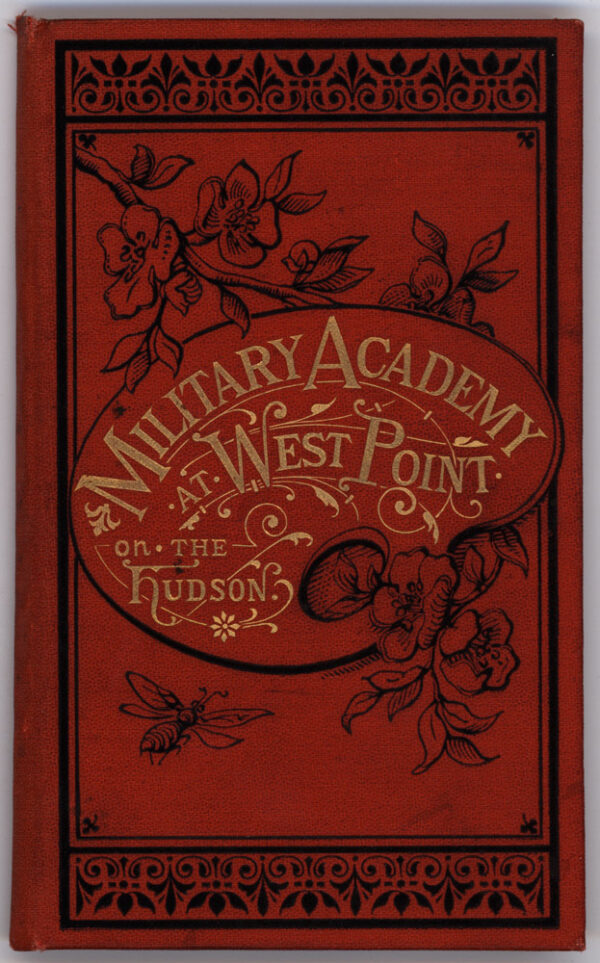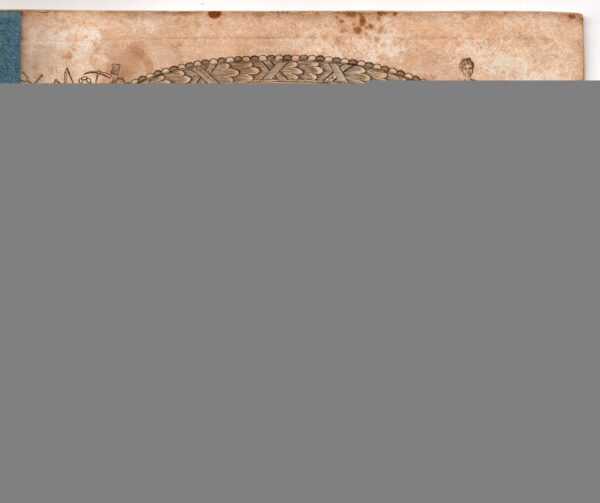
Murphy, J.F.
Oblong 64mo (3.25" x 5"), red cloth stamped title and ornamental borders in black. 12 accordion-folding lithographic plates, first plate affixed to pastedown, three plates with two images. CONDITION: Good, bright covers, all plates present, one with a 1" tear, clean and fresh. A charming souvenir book of the Fall River steamship line, with images of the New York and Boston depots, interior of the Pilgrim steamer, and the Bristol, Providence and Pilgrim steamers traveling through their waterways

Salaman, Malcolm C.
4to (11.75" x 9.25"), black cloth, gilt title at front cover and spine, front-cover gilt illustration of a laborer on a pressing machine. 35 pp. 96 plates (approx. 5" x 7" to 7" x 5"), 16 photo engravings each with a guard sheet with descriptive letterpress and 1 woodcut. CONDITION: Light wear to cover extremities; contents very good, light wear. First edition. Introduction by Malcolm C. Salaman, with a Chronological List of Haden's Etchings and Mezzotints. English surgeon and artist Sir Seymour Haden (1818-1910) is best remembered for his etched work. Haden was one of a number of artists such as James McNeill Whistler (1834-1903) and Alphonse Legros (1837-1911) whose interest in the medium led to the Etching Revival, which lasted well into the twentieth century. Haden wrote that the line of the etching needle was "free, expressive, full of vivacity."

Knapp, S. A., et al.
8vo (9" x 6"), printed tan wrappers. 71, [2] pp., illus. Faded agent stamp on front wrapper. CONDITION: Very good, re-backed, chips to edges of wrappers neatly filled in, one minor stain on p. 37. An appealing pamphlet picturing and detailing Southwest Louisiana for the prospective settler and capitalist. The text offers a full description of Southwest Louisiana along the line of the Southern Pacific Railroad, where some 10,000 Northerners have located homes. Covered here is the production of sugar; fruit growing (several letters concerning fruit growing in the state are reproduced); truck farming; the climate and its "advantages," and the cultivation of rice on the prairies (including a list of rice planters in the area and the number of acres they own). Also detailed are Southwest Louisiana's grasses, machinery, "safe and profitable investments," Lake Charles College, feed for stock ("the problem of cheap feed for stock"), value and price of land, Southern homes, Joseph Jefferson's Orange Island (near New Iberia), the abundant plant Palmetto, cotton, timber, Lake Charles, minerals, topography, roads, water, and insects. A number of Louisiana regions are described, including Welsh, Jennings, Lake Arthur, Shell Beach, Acadia Parish, La Fayette, Vermillion Parish, and Jeanerette. The text concludes with a note on choice lands in Texas by a land commissioner in Houston. The illustrations show sugar cane fields, a pear orchard, an orange grove, residences and families, scenes of laborers harvesting, threshing, and shipping rice, a stock farm, a live oak tree, black workers in cotton fields, a tramway transporting lumber, and a rice flume. The map, entitled "Map of Southwestern Louisiana," shows the Southern Louisiana Railroad extending from New Orleans into Texas. Promoted on the verso of the front wrapper is the Southern Pacific Company's "Sunset Route."

Oblong 16mo (6.25" x 8.2"), original blue wrappers with red paper spine. Engraved title leaf, 15 engraved plates. CONDITION: Good+, moderate wear to wrappers; foxing to contents. The 1831 edition of this elaborate and charming German-English penmanship book by important German-American engraver and almanac astronomist Carl Friederich Egelmann. Enclosed within an ornamental frame with a figure of Justice, a globe, and tools of mathematics and agriculture at each corner, short original poems on either side of the title invite the reader in both German and English to "Come buy this book" / "O! Kauf dis Buch." The following fifteen plates cover several German scripts-Kurrent, Fraktur, and "Canzelen Schrift" (a variation of the bureaucratic Kanzleischrift); the "English or Latin Alphabet"; "Chymical Signs" (in both English and German), and even cross-stitch letters and symbols "for marking on linen." In addition to alphabets and word lists are original poems signed in the plate by Egelmann and a variety of sampler texts, three of which are delightfully illustrated: "Vom Löwen" ("On Lions"); "Vom Elephanten" ("On Elephants"); and "Ermahnung an die Jugend" ("Reminder" or "Admonition to Children"). Unlike the version in earlier editions, the latter plate includes a small detail engraving to the left of the text illustrating how to use the "thumb and first two fingers of the right hand to hold the quill, and of the left hand to hold the paper." One of the plates here contains sampler text filled in with two dates in 1831. Nash identifies three editions of this work, in 1821, 1823, and 1831; a Library Company of Philadelphia exhibition catalog from 1983 notes "at least four editions between 1820 and 1831." Carl Friederich Egelmann (1782-1860) was born in Germany to a titled family. After serving as secretary to a baron in his late teens, he emigrated to the United States in 1802. He spent several years apprenticed to a coach maker (during which time he made the body of a coach for the brother of Napoleon), and learned copperplate engraving in his spare time. With his wife Anna Maria Schert (m. 1808) Egelmann eventually moved to Pennsylvania, first to Chester, where he taught school in both English and German, and then to Reading, where he launched his career as an engraver, becoming "the world's most productive almanac calculator. His calculations, articles, notes, illustrations and poems made a significant social and cultural impact on the life of the Pennsylvania Germans and people of surrounding areas during the 19th Century" (Winkler, p. 12). REFERENCES: Nash, American Penmanship 1800-1850 136; Germantown and the Germans (Philadelphia, 1983) 14; Winkler, Louis. "Pennsylvania German Astronomy and Astrology VII: Carl Friederich Egelmann," Pennsylvania Folklife Vol. 23, No. 1 (1973).

Egelmann, Carl Friederich, engr., comp
Oblong 16mo (6.25" x 8.2"), original blue wrappers with red paper spine. Engraved title leaf, 15 engraved plates. CONDITION: Good+, moderate wear to wrappers; foxing to contents. The 1831 edition of this elaborate and charming German-English penmanship book by important German-American engraver and almanac astronomist Carl Friederich Egelmann. Enclosed within an ornamental frame with a figure of Justice, a globe, and tools of mathematics and agriculture at each corner, short original poems on either side of the title invite the reader in both German and English to "Come buy this book" / "O! Kauf dis Buch." The following fifteen plates cover several German scripts-Kurrent, Fraktur, and "Canzelen Schrift" (a variation of the bureaucratic Kanzleischrift); the "English or Latin Alphabet"; "Chymical Signs" (in both English and German), and even cross-stitch letters and symbols "for marking on linen." In addition to alphabets and word lists are original poems signed in the plate by Egelmann and a variety of sampler texts, three of which are delightfully illustrated: "Vom Löwen" ("On Lions"); "Vom Elephanten" ("On Elephants"); and "Ermahnung an die Jugend" ("Reminder" or "Admonition to Children"). Unlike the version in earlier editions, the latter plate includes a small detail engraving to the left of the text illustrating how to use the "thumb and first two fingers of the right hand to hold the quill, and of the left hand to hold the paper." One of the plates here contains sampler text filled in with two dates in 1831. Nash identifies three editions of this work, in 1821, 1823, and 1831; a Library Company of Philadelphia exhibition catalog from 1983 notes "at least four editions between 1820 and 1831." Carl Friederich Egelmann (1782-1860) was born in Germany to a titled family. After serving as secretary to a baron in his late teens, he emigrated to the United States in 1802. He spent several years apprenticed to a coach maker (during which time he made the body of a coach for the brother of Napoleon), and learned copperplate engraving in his spare time. With his wife Anna Maria Schert (m. 1808) Egelmann eventually moved to Pennsylvania, first to Chester, where he taught school in both English and German, and then to Reading, where he launched his career as an engraver, becoming "the world's most productive almanac calculator. His calculations, articles, notes, illustrations and poems made a significant social and cultural impact on the life of the Pennsylvania Germans and people of surrounding areas during the 19th Century" (Winkler, p. 12). REFERENCES: Nash, American Penmanship 1800-1850 136; Germantown and the Germans (Philadelphia, 1983) 14; Winkler, Louis. "Pennsylvania German Astronomy and Astrology VII: Carl Friederich Egelmann," Pennsylvania Folklife Vol. 23, No. 1 (1973).

[Pearson, Thomas.]
8vo (8.25" x 5.25"), marbled wrappers with pasted label "Steel tempering edge tools 1831." 18 pp., 2 folding plates printed on yellow paper (6" x 14.25" plus margins; 8.25" x 6.75" plus margins). The second plate credited to "Browne, del." Text signed in type on p. 18: "New York, November, 1830 T[homas] P[earson]." Ownership inscription on ffep, "Jn Hutchinson 25 Maiden Lane." Early inscription on ffep, "Important axe-makers, factories, and foundries." CONDITION: Good, minor losses and chipping to wrappers, paper largely perished at spine; some toning and light foxing to contents, but generally well preserved and attractive. A scarce promotional work by the important British steel manufacturer Naylor & Co., published in New York and including two lithographic plates by Pendleton, one depicting the company's steel works and the other its metallic bath. The Sheffield, England steel manufacturer Naylor & Co. (later Naylor, Vickers & Co., and then Vickers, Sons, & Co.) operated an extensive business in the U.S. and was crucial to its rapid industrialization. The company's steel was used widely in America for the manufacture of a range of hardware such as axes, tools, knives, and cutlery, and was used by engravers, machinists, tool-makers, and others. The text covers over a dozen different types of steel the company produced and their uses. A portion of the text describes the plate depicting the company's metallic bath and provides detailed instructions on how to use it to harden and temper edge tools. This publication was intended not only to provide technical insight but also as an advertising and promotional tool to underscore the firm's high quality products. While this was before the revolutionary Bessemer process was developed in the 1850s, the U.S. offices of Naylor & Co. were important players in the key advancements behind the Second Industrial Revolution. One of the company's techniques was to send sales representatives to American customers to provide technical advice on their metallurgical problems. An early and leading lithographic firm operating from 1825 to 1836, Pendleton's was founded by brothers William Pendleton (1795-1879) and John Pendleton (1798-1866) and was located at Harvard Place in Boston-the city's first shop of its kind. A splinter group from Pendleton's Lithography comprising Thomas Edwards and Moses Swett founded Senefelder Lithographic Co. in 1828 in Boston, but by 1831 the firm was absorbed by Pendleton Lithography. A range of artists-some of whom would become quite prominent-learned the art of lithography while working at Pendleton's, including Fitz Henry Lane, John H. Bufford, Nathaniel Currier, Benjamin Champney, David Claypoole Johnston, Robert Cooke, and John W. A. Scott. These artists created a variety of materials: maps, plans, portraits, fashion plates, topographical views, sheet-music covers, advertisements, and historical prints. In 1826, the brothers won a silver medal for the "Best Specimen of Lithography" at the annual exhibition of the Franklin Institute, Philadelphia. In 1829 John Pendleton went to Philadelphia to start the firm of Pendleton, Kearney & Childs, and moved later in the same year to New York to start his own company. OCLC records three copies in the US and one in the UK. REFERENCES: Last, Jay. The Color Explosion : Nineteenth-Century American Lithography (Santa Ana, California, 2005), pp. 122-23, 161; Pierce, Sally and Catharina Slautterback. Boston Lithography, 1825-1880 (Boston, 1991), pp. 146-47, 175.

Illustrated broadside, 26.25" x 9" plus margins. Place and time of appearance stamped in black below title. CONDITION: Good, torn in half across center and repaired on verso with tissue, small piece of cloth tape adhered to edge of top margin, a few tiny punctures, .5" x 1.5" loss at lower margin, no losses to the text. An unrecorded broadside advertising an appearance in Gardiner, Maine of Ducello's touring zoological exhibition, featuring illustrations of lion tamers performing with lions and exotic wild animals. This production of Dan Ducello's Zoological Exhibition and Museum of Living Wonders took place on Wednesday and Thursday, the 24th and 25th of October, ca. 1880. The exhibition embraced rare living wild animals from around the world including a very large African lion and lioness, whose keeper was to enter the den with them and put his head in the lion's mouth in full view of the audience. It is claimed here that this keeper was the only animal trainer in the U.S. who successfully performed this daring feat. Also part of the exhibition were the large African Spotted Hyenas (or "the man eaters of Africa"; "these animals are savage, untamable and possess great strength"), as well as Tigers, Leopards, Panthers, Bears, Monkeys, Apes, and more. Ducello was to explain and lecture on the various natures and habits of the wild animals. The exhibition started at 2 O'clock, and at 3 O'clock all the wild animals were fed, which gave every visitor an opportunity of witnessing "one of the grandest sights ever seen in this place." Elevated seats were arranged such that the entire audience could have an unobstructed view of the animals in their cages while being fed. "Everyone will have an opportunity to witness, at their leisure, the works of the great creator." It is emphasized that this is a "moral and instructive exhibition which every person, old and young, should surely attend." Ducello, identified here as the business manager, is known to have operated Dan Ducello's Zoological Exhibition from at least 1876 to 1879. W. Wilder is identified as Treasurer and C. H. Henderson is listed as Business Agent. No copies of this broadside recorded in OCLC. REFERENCES: Slout, William Lawrence. Olympians of the Sawdust Circle (San Bernardino, CA: The Borgo Press, 1998), p. 85.

Wright, Henry C.
16mo (6.4" x 4.5"), self-wrappers. 12 pp. CONDITION: Good, light soiling to covers and throughout. A scarce and incendiary anti-war attack on presidential candidate Zachary Taylor, pairing a sensational true story of murder-for-hire with gruesome details of Mexican-American War atrocities perpetrated, according to the author, by the U.S. Army under Taylor's command, printed in the utopian community of Hopedale, Mass. In this tract, published in the year the Mexican-American War ended and during Taylor's Presidential bid in the election of 1848, Henry C. Wright compares war-hero Taylor to assassin Dick Crowningshield, who in 1830 was hired by the Knapp brothers to kill their wealthy uncle Captain Joseph White, from whom they anticipated an inheritance. Crowningshield took his own life in prison, while the Knapp brothers were prosecuted as accessories to murder and both received the death penalty. Wright points out the inconsistency that "Zachary is counted worthy of all honor by a professedly enlightened, civilized, republican and Christian people, and is by them elevated to the Presidency; Dick, by the same people, is elevated to the gallows." Wright uses extremely graphic and bloody references to accuse Taylor of being a mass murderer, and argues there are no differences between him and Crowningshield-except that Taylor used the support of his government to murder, rape, and pillage: Zachary promised the people protection if they would yield. They did. How did he protect them? Let an eyewitness tell. Zachary, "for the sake of popularity, neglected to restrain the passions of his volunteers." "MURDER, ROBBERY and RAPE were committed in broad day-light; and, as if desirous to signalize themselves at Monterey by some new acts of atrocity, they burned many of the thatched huts of the poor peasants." .Taylor and every soldier [are] certainly a murderer and an assassin as was Dick Crowninshield. Raised in New York, Henry Clarke Wright (1797-1870) was a radical abolitionist, feminist, and pacifist who attracted much controversy during his life. Excluded by the American Anti-Slavery Society in 1837 for being too radical, Wright sought an immediate (though non-violent) means of ending slavery. He spent some time in Britain in the 1840s and accompanied Frederick Douglass to antislavery meetings, though Douglass was often wary of traveling with Wright due to his uncompromising views. Wright worked with the American Peace Society and the Grimké sisters, and following the Civil War continued to lecture on abolition and the rights of African Americans. Established in 1843 by the radical minister Adin Ballou (1803-1890), Hopedale Community in Milford, Mass. espoused proto- libertarian positions on the state's use of violence and the individual's responsibility to refrain from participating in state violence. Hopedale's printing office was one of several industries the Community created to make their joint-stock socialist venture profitable. Wright's pamphlet was published after the women of Hopedale voted to earmark ten dollars toward its distribution. This is the only recorded publication bearing the imprint of the "Non-Resistant and Practical Christian Office." There are, apparently, two issues of this work, both published in 1848: the present version and another published under the variant title The Employers of Dick Crowninshield, the Assassin and the Employers of Zachary Taylor, the Soldier : the Difference. REFERENCES: D'Amato, David S. "Christian Non-resistance and the Hopedale Community" (12 June 2017) at libertarianism online; Murray, Hannah. "Henry Clarke Wright" at Frederick Douglass In Britain and Ireland online.






